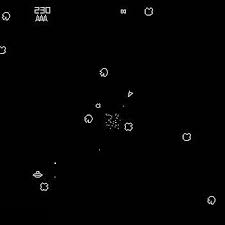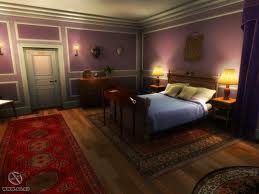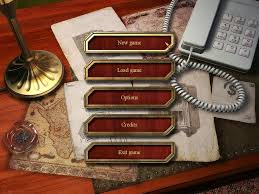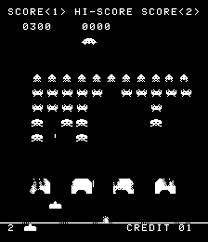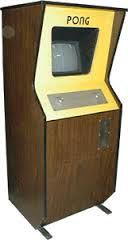Lode Runner
The prototype of what later became Lode Runner was a game developed by Douglas E. Smith of Renton, Washington, who at the time was an architecture student at the University of Washington.[3] This prototype, called Kong, was written for a Prime Computer 550 minicomputer limited to one building on the UW campus. Shortly thereafter, Kong was ported to VAX minicomputers, as there were more terminals available on campus. The game was programmed in Fortran and used ASCII character graphics. When Kong was ported to the VAX, some Pascal sections were mixed into the original Fortran code.
Over one weekend in 1982, Smith was able to build a crude, playable version in 6502 assembly language on an Apple II+ and renamed the game Miner. Through the end of the year, he refined that version, which was black-and-white with no joystick support. He submitted a rough version to Brøderbund around October 1982 and received a one-line rejection letter in response to the effect of "Sorry, your game doesn't fit into our product line; please feel free to submit future products."
Smith then borrowed money to purchase a color monitor and joystick and continued to improve the game. Around Christmas of 1982, he submitted the game, now renamed Lode Runner, to four publishers and quickly received offers from all four: Sierra, Sirius, Synergistic, and Brøderbund. He took the deal with Brøderbund.
Miner, like its text-based Kong predecessors, had only very simple animation where characters move across the screen in block increments. It was too primitive for an acceptable commercial product as Brøderbund wanted detailed pixel-level movement.[4] According to this article, Smith was given a $10,000 advance by Brøderbund to develop the inter-square animation, and to provide 150 levels of play. For the latter, he reputedly paid neighborhood children to design levels with the editor he had coded.
The game was released in mid-1983. The original microcomputer versions included the Apple II series, the Atari 8-bit family, the VIC-20, the Commodore 64, the IBM PC, and a Konami version licensed for the MSX computer named King's Valley. This was then released for the Sega Mark I console with only minor changes. A port for the original 128k Macintosh followed in 1984. Versions include those for the Atari ST, Sinclair Spectrum 48K/128K, NES, Windows 3.1, Macintosh, and the original Game Boy.
Most versions of Lode Runner were on disk, but the Atari 8-bit and Commodore 64 also got a "lite" cartridge version with only 32 levels and no editor for users without disk drives. The VIC-20 port was cartridge only but did include a level editor which allowed saving to cassette tape. The NES version was released by Hudson Soft in 1984 (North American release 1986) and became one of the earliest third-party games made for that system. It had 50 levels, scrolling screens, and graphics redone in a more cartoon-like style. In addition, an arcade game of Lode Runner was produced with some added features like the ability to hang off the ends of ladders.
Brøderbund released a special enhanced version, Championship Lode Runner, the following year. It only had 50 levels, but with much higher difficulty than the original. The company offered a commemorative certificate to anyone who could submit proof of having beaten the entire game. It was ported to the Apple, Atari, C64, and PC, as well as the NES (although that version did not reach North America).
Asteroids
Asteroids is an arcade space shooter released in November 1979[1] by Atari, Inc. and designed by Lyle Rains and Ed Logg. The player controls a spaceship in an asteroid field which is periodically traversed by flying saucers. The object of the game is to shoot and destroy asteroids and saucers while not colliding with either, or being hit by the saucers' counter-fire. The game becomes harder as the number of asteroids increases.
Asteroids was conceived during a meeting between Logg and Rains and used hardware developed by Howard Delman previously used for Lunar Lander. Based on an unfinished game titled Cosmos and inspired by Spacewar! and Computer Space, both early shoot 'em up video games, Asteroids' physics model and control scheme were derived by Logg from these earlier games and refined through trial and error. The game is rendered on a vector display in a two-dimensional view that wraps around in both screen axes.
Acclaimed by players and video game critics for its vector graphics, controls, and addictive gameplay, Asteroids was one of the first major hits of the golden age of arcade games. The game sold over 70,000 arcade cabinets and proved both popular with players and influential with developers. It has since been ported to multiple platforms. Asteroids was widely imitated and directly influenced two popular and often cloned arcade games, Defender and Gravitar, as well as many other video games.
Safecracker
Safecracker is a 1997 point and click adventure game published by Dreamcatcher Interactive and developed by Daydream Software for both PC and Mac OS X computers.<|p>
As an aspiring head of security development at Crabb & Sons Safe and Security Systems, your goal is to break into and navigate your eccentric employer's sprawling 50-room mansion with the goal of unlocking 35 different hidden safes and stealing their contents undetected, in the process piecing together several codes to unlock one safe that contains your job contract.
The game plays much like Myst, where the player navigates through pre-rendered backgrounds in a first-person view using Qucktime VR in an attempt to solve various puzzles.<|p>
Space Invaders
Space Invaders is an arcade video game developed by Tomohiro Nishikado and released in 1978. It was originally manufactured and sold by Taito in Japan, and was later licensed for production in the United States by the Midway division of Bally. Space Invaders is one of the earliest shooting games and the aim is to defeat waves of aliens with a laser cannon to earn as many points as possible. In designing the game, Nishikado drew inspiration from popular media: Breakout, The War of the Worlds, and Star Wars. To complete it, he had to design custom hardware and development tools.
It was one of the forerunners of modern video gaming and helped expand the video game industry from a novelty to a global industry (see golden age of video arcade games). When first released, Space Invaders was very successful.<|p>
The game has been the inspiration for other video games, re-released on numerous platforms, and led to several sequels. The 1980 Atari 2600 version quadrupled the system's sales and became the first "killer app" for video game consoles. Space Invaders has been referenced and parodied in multiple television shows, and been a part of several video game and cultural exhibitions. The pixelated enemy alien has become a pop culture icon, often used as a synecdoche representing video games as a whole.
Pong
Pong (marketed as PONG) is one of the earliest arcade video games; it is a tennis sports game featuring simple two-dimensional graphics. While other arcade video games such as Computer Space came before it, Pong was one of the first video games to reach mainstream popularity. The aim is to defeat an opponent in a simulated table-tennis game by earning a higher score. The game was originally manufactured by Atari Incorporated (Atari), who released it in 1972. Allan Alcorn created Pong as a training exercise assigned to him by Atari co-founder Nolan Bushnell. Bushnell based the idea on an electronic ping-pong game included in the Magnavox Odyssey, which later resulted in a lawsuit against Atari. Surprised by the quality of Alcorn's work, Bushnell and Dabney decided to manufacture the game.
Pong quickly became a success and is the first commercially successful arcade video game machine, which helped to establish the video game industry along with the first home console, the Magnavox Odyssey. Soon after its release, several companies began producing games that copied Pong's gameplay, and eventually released new types of games. As a result, Atari encouraged its staff to produce more innovative games. The company released several sequels that built upon the original's gameplay by adding new features. During the 1975 Christmas season, Atari released a home version of Pong exclusively through Sears retail stores. It was also a commercial success and led to numerous copies. The game has been remade on numerous home and portable platforms following its release. Pong has been referenced and parodied in multiple television shows and video games, and has been a part of several video game and cultural exhibitions.


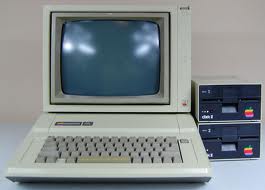


 Five Pages of Fab Fives
Five Pages of Fab Fives 


